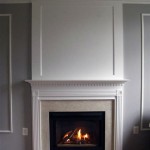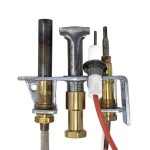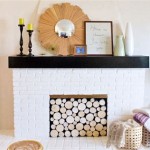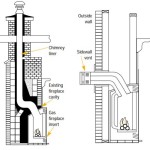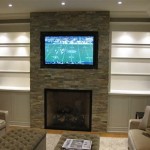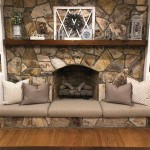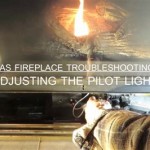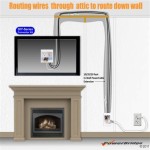Painting A Fireplace Insert: A Comprehensive Guide
A fireplace insert, a self-contained heating unit designed to fit within an existing fireplace opening, can become a focal point of a room. Over time, however, the original finish can fade, chip, or simply become outdated. Painting a fireplace insert offers a cost-effective way to rejuvenate its appearance and integrate it seamlessly with the surrounding décor. This article provides a detailed guide to safely and effectively painting a fireplace insert, ensuring a durable and aesthetically pleasing result.
Before undertaking any painting project, understanding the materials and their properties is crucial. Fireplace inserts are generally constructed from cast iron, steel, or a combination of both. Identifying the insert's material is essential for selecting the appropriate paint and preparation methods. Additionally, the type of fuel burned in the fireplace (wood, gas, or electric) dictates the level of heat resistance required from the paint. Wood-burning inserts, for example, generate significantly higher temperatures than gas or electric models.
Safety is paramount when working with any heating appliance. The insert must be completely cool before starting any preparation or painting. Furthermore, the area surrounding the fireplace should be well-ventilated to prevent the build-up of fumes from cleaning agents or paint. Wearing appropriate personal protective equipment (PPE), including gloves, eye protection, and a respirator, is also highly recommended.
Preparing the Fireplace Insert for Painting
Proper preparation is the foundation of a successful paint job. Thorough cleaning and surface preparation ensure optimal paint adhesion and a long-lasting finish. The first step involves removing any loose debris, soot, or rust from the insert's surface. A wire brush or scraper can be used to dislodge stubborn deposits. For more ingrained dirt and grime, a specialized fireplace cleaner or a solution of trisodium phosphate (TSP) can be applied. Always follow the manufacturer's instructions when using chemical cleaners and rinse thoroughly with clean water.
After cleaning, the surface should be thoroughly inspected for rust. Even small patches of rust can compromise the integrity of the paint finish. Rust can be removed by using a wire brush, sandpaper, or a chemical rust remover. For extensive rust, a power sander may be necessary. Once the rust is removed, the area should be treated with a rust converter to prevent further corrosion.
Sanding the surface of the fireplace insert creates a slightly roughened texture, enhancing paint adhesion. Use a medium-grit sandpaper (around 120-180 grit) to lightly sand the entire surface. Avoid applying excessive pressure, as this can damage the underlying metal. After sanding, thoroughly remove any sanding dust with a tack cloth or a vacuum cleaner with a brush attachment. This step is crucial for achieving a smooth and even finish.
Masking off areas that are not to be painted is essential to prevent unwanted paint splatters. Use painter's tape and drop cloths to protect the surrounding wall, floor, and any decorative elements. Pay particular attention to masking off the glass door (if applicable) and any intricate details on the insert's surface.
Selecting the Right Paint
Choosing the appropriate paint is critical for ensuring the durability and longevity of the finish. Regular latex paint is not suitable for fireplace inserts, as it cannot withstand the high temperatures. High-heat paint, specifically designed for stoves, grills, and other high-temperature surfaces, is required. These paints are typically available in aerosol cans or liquid form and are formulated to withstand temperatures up to 1200°F.
High-heat paints come in a variety of finishes, including matte, satin, and metallic. The choice of finish depends on personal preference and the overall aesthetic of the room. Matte finishes tend to be more forgiving of imperfections, while satin finishes offer a subtle sheen. Metallic finishes can add a touch of elegance but may be more challenging to apply evenly.
When selecting a high-heat paint, it is essential to consider the type of fuel burned in the fireplace. Wood-burning inserts require paints with a higher heat resistance than gas or electric models. Always consult the paint manufacturer's specifications to ensure that the paint is suitable for the intended application.
Primer is often recommended for ensuring optimal paint adhesion, especially on bare metal surfaces. A high-heat primer, specifically formulated for use with high-heat paints, should be applied before painting. The primer creates a uniform surface and helps to prevent rust from reappearing.
Applying the Paint
Before applying the paint, thoroughly shake the can or stir the liquid paint according to the manufacturer's instructions. Apply the paint in thin, even coats, using smooth, overlapping strokes. Avoid applying thick coats, as this can lead to runs and drips.
For aerosol paints, hold the can approximately 8-12 inches away from the surface and move the can at a steady pace. Apply several thin coats, allowing each coat to dry completely before applying the next. For liquid paints, use a high-quality brush or roller designed for high-heat applications. Apply the paint in thin, even coats, following the grain of the metal (if applicable).
Allow the paint to dry completely according to the manufacturer's instructions. This may take several hours or even overnight. Avoid touching the painted surface during the drying process to prevent smudging or fingerprints. Once the paint is completely dry, carefully remove the masking tape and drop cloths.
After the paint has dried, the fireplace insert may need to be cured. Curing involves gradually increasing the temperature of the insert to fully harden the paint. The paint manufacturer's instructions will specify the curing process, which typically involves burning a small fire or turning on the electric heat at a low setting for a specified period of time. Curing helps to ensure the durability and heat resistance of the paint finish.
Proper ventilation during and after painting is crucial. Open windows and doors to allow fresh air to circulate. A fan can also be used to help dissipate fumes. Avoid using the fireplace until the paint is fully cured and the fumes have completely dissipated. This process will ensure the painted insert is safe for use.

How To Spray Paint A Brass Fireplace Insert Erfly House

How To Spray Paint A Brass Fireplace Insert Erfly House

How To Spray Paint A Brass Fireplace Insert Erfly House

How To Spray Paint A Brass Fireplace Insert Inserts Glass

How To Spray Paint A Brass Fireplace Insert Erfly House

How To Update Brass Fireplace Insert With Spray Paint Iekel Road Home

How To Spray Paint A Brass Fireplace Bright Green Door

How To Paint Metal Fireplace Surround Four Generations One Roof

How To Prep Prime And Paint A Brick Fireplace Young House Love

Painted Fireplace Insert Step By Tutorial Prodigal Pieces
Related Posts

